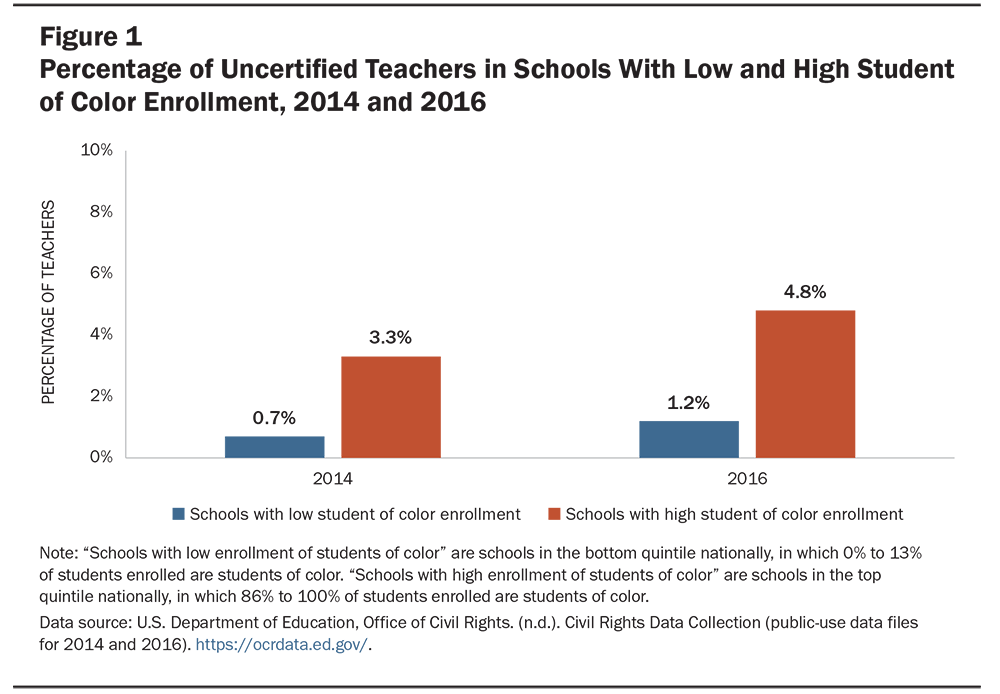Decades of research show that access to fully certified and experienced teachers matters for student outcomes and achievement. Yet, providing all students with equitable access to such teachers has long been a struggle in U.S. schools. Recent teacher shortages have exacerbated these inequities in access, which disproportionately fall on students of color. This is especially concerning since achievement gaps between students of color and white students are substantially explained by inequitable access to qualified teachers.
Inequitable Opportunity to Learn: Student Access to Certified and Experienced Teachers draws from the most recent state and national data from the U.S. Department of Education’s bi-annual Civil Rights Data Collection (CRDC) to shed light on the extent of inequities in student access to certified and experienced teachers. The CRDC provides extensive data on teacher experience and school-level funding, including information on the salaries of teachers and other school personnel, staff-to-student ratios, and personnel and non-personnel expenditures.
Research shows that teacher qualifications and experience matter for the opportunities students have to learn, their well-being, and their academic outcomes.
Despite the importance of these data, Department of Education is proposing the elimination of a number of questions, including key questions related to educator experience. In this letter to the Department, LPI explains why these data—which have been collected every 2 years from all public schools and school districts in the United States since 1968—are essential for fostering equity and access in education.
Researchers examined the two most recent CRDCs (2014 and 2016) to assess the degree to which students of color (including African American, Asian, Latino/a, Native American, Pacific Islander, and students of two or more races) have access to certified and experienced teachers compared to their white peers. The report also provides key policy strategies for increasing student access to certified and experienced teachers.
Research Findings
Nationally, urban schools have the largest percentages of uncertified and inexperienced teachers, but CRDC data show that in all kinds of schools—rural, suburban, and urban—students in schools with high enrollment of students of color have less access to certified and experienced teachers than their white peers.
- Schools with high enrollments of students of color were four times as likely to employ uncertified teachers as were schools with low enrollment of students of color.
- Students in schools with high enrollments of students of color have less access to experienced teachers. In these schools, nearly one in every six teachers is just beginning his or her career, compared to one in every 10 teachers in schools with low enrollment of students of color.
- In 13 states (Alaska, Connecticut, Delaware, Kansas, Massachusetts, Mississippi, Nevada, New Jersey, New York, Ohio, Oklahoma, Pennsylvania, and Washington), there are about twice as many inexperienced teachers in schools with high enrollment of students of color compared to the share of inexperienced teachers in schools with low enrollment of students of color.
- In five states (Georgia, Indiana, Maryland, Rhode Island, and Tennessee), there are at least three times as many inexperienced teachers in schools with high enrollment of students of color compared to the share of inexperienced teachers in schools with low student of color enrollment.

Policy Recommendations
The report concludes with policy recommendations for closing gaps in student access to certified and experienced teachers, including:
- Enforcing federal comparability requirements that encourage the equitable distribution of more experienced, certified teachers and discourage the concentration of novice and uncertified teachers in high-need schools.
- Strengthening educator pipelines by implementing and maintaining federal and state loan forgiveness and service scholarship programs that can recruit, prepare, and retain high-quality teachers in the academic fields and in the schools in which they are most needed.
- Creating more equitable state funding systems to provide for higher and more equitable teacher salaries and improved working conditions in underserved districts, both of which can increase teacher retention.
- Supporting high-quality teacher residency programs through increases in state and federal funding.
- Providing novice teachers with mentoring, support, and other professional learning opportunities.
- Compensating National Board Certified teachers who work in high-need schools and who can serve as expert mentors for novices in those schools.
- Supporting principal training at the state and local levels, since principals have a strong influence on teacher retention.
The report is the first of three that will draw insights from the CRDC on policy solutions to improve all students’ opportunities to learn and succeed in school, college, career, and civic life. Subsequent reports will examine student access to advanced courses and inclusive school discipline practices.
Inequitable Opportunity to Learn: Student Access to Certified and Experienced Teachers is authored by Jessica Cardichon, Linda Darling-Hammond, Man Yang, Caitlin Scott, and Dion Burns. Read the full report at this link.
Inequitable Opportunity to Learn: Student Access to Certified and Experienced Teachers by Jessica Cardichon, Linda Darling-Hammond, Man Yang, Caitlin Scott, Patrick M. Shields, and Dion Burns is licensed under a Creative Commons Attribution-NonCommercial 4.0 International License.
Core operating support for the Learning Policy Institute is provided by the Sandler Foundation and the William and Flora Hewlett Foundation. We are grateful to them for their generous support. The ideas voiced here are those of the authors and not those of our funders.
